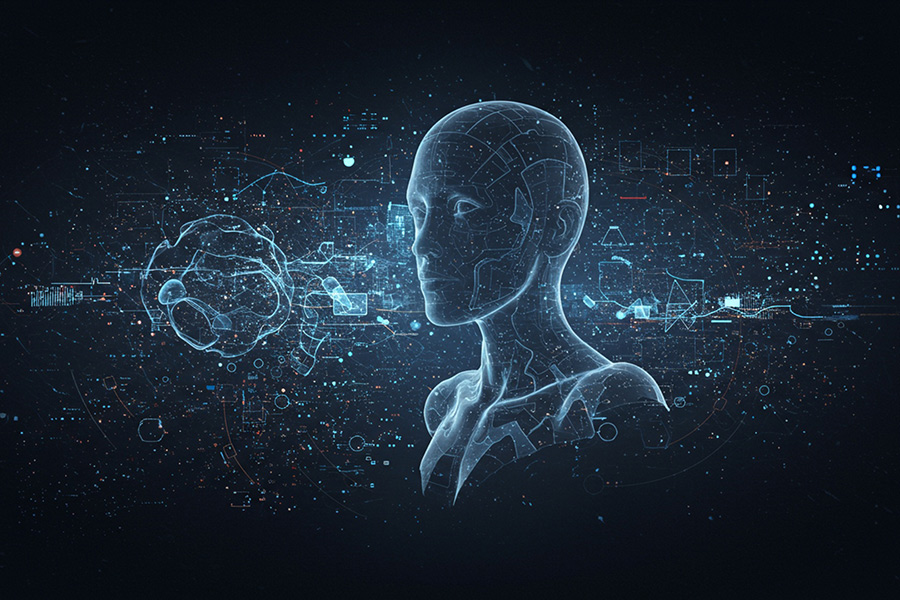Andrew Ng’s words highlight a significant change in mobile tech. By 2025, AI in mobile apps will be necessary for our lives and work. It will change how we track health, translate languages, and more.
As we approach 2025, apps will become brighter. These 2025 trends aim to create apps that know us better and connect us in new ways. Businesses that don’t keep up will fall behind, as 83% of consumers now expect AI features.
The future isn’t just a dream—it’s the next step in mobile technology. This article outlines the innovations coming and why leaders need to act now.
The Revolution of AI in Mobile Apps: Where We Stand Today
AI is now a part of our everyday lives. It helps us get personalized music and translate languages in real-time. The way AI is transforming mobile apps has quietly changed the game, and these changes are making big waves in many industries.
How AI Has Transformed Mobile Experiences
Apps like Spotify and TikTok use AI to offer content that feels right for you. Health apps like Ada Health check your symptoms, and fitness apps predict your workout needs.
These tools make life easier by saving time and making things more seamless. AI works behind the scenes to make these experiences possible.
Current Adoption Rates Across Industries
Research shows 65% of Fortune 500 companies use AI in their mobile apps. Retail and healthcare lead the way. Banking apps like Chase use AI to spot fraud.
Car companies like Tesla use AI in their apps for car management. Even small businesses use chatbots to help with customer service. AI is helping all kinds of companies.
The Foundation for 2025’s Innovations
Today’s progress is setting the stage for tomorrow’s big leaps. Companies like Google and Apple offer tools for developers. These tools help make apps more thoughtful and more efficient.
Cloud and edge computing make AI faster and more reliable. These steps are not just updates. By 2025, they’ll start reshaping industries with personalized services and smart decisions.
AI in Mobile Apps: Trends 2025 – What’s on the Horizon
The future of AI in mobile apps is exciting. Developers are working on apps that know what we need and like. This guide will show you what’s coming by 2025, inspiring innovators and businesses.
Imagine apps that read our emotions through our faces or voices. Emotion AI will change mental health and customer service, making interactions more caring. Voice-first interfaces, powered by advanced NLP, will soon replace touchscreens. Soon, we’ll order groceries or manage money just by talking.
AI will make apps super personal. They’ll suggest content, products, and health tips based on our habits in real-time. Google and Apple already use predictive analytics in wearables, so apps could soon be our health coaches.
New biometric tech and AI that cares about privacy will boost security. New systems might replace passwords with behavior checks. Federated learning will keep data safe while making apps more intelligent. These steps will make apps safer and more convenient.
AR and IoT will bring 3D interfaces to our phones, turning them into portals to new realities. Retail apps might use AR to let us see furniture in our homes, and IoT-linked apps will make our homes smarter with AI. Guided by guides like this, this is a big step forward.
Breaking Boundaries: Core AI Technologies Reshaping Mobile Applications
AI technologies are changing how mobile apps work. They use machine learning and predictive analytics to make smartphones smarter. Now, phones can understand us better and help us guess what we might want next.
The Evolution of Machine Learning in Mobile Environments
Machine learning works on phones, making tasks like translating and recognizing faces fast. Apple and Google have created special tools for this. This means apps can edit photos or allow us to talk to each other without the internet.
- Natural Language Processing – Beyond Basic Commands: NLP has grown significantly. It can now understand tone, sarcasm, and more. This allows apps like Alexa and WhatsApp to handle complex requests. Google’s BERT models even make voice interactions feel more natural.
- Predictive Analytics – Anticipating User Needs Before They Do: Predictive analytics helps apps guess what we might want. Netflix and Amazon use it to suggest movies and products. Health apps even predict our workout needs or what we might eat. It makes apps more proactive and helpful.
- Computer Vision – Applications in Everyday Apps: Smartphones can now “see” the world in new ways. Medical apps can diagnose skin issues from photos. Snapchat’s AR filters add 3D effects to real scenes. Even grocery apps can scan items with just a photo.
The Hyper-Personalization Era: Creating Truly Individual Experiences
Imagine a world where your apps know you better than you know yourself. This is what AI-driven personalized experiences in 2025 promise. Tomorrow’s apps will use data like location, biometrics, and behavior to guess what you need before you ask.
A fitness app might change your workout plan based on your stress levels from a smartwatch. A shopping app could suggest outfits based on your mood, detected by facial recognition. These tailored recommendations will feel like having a digital friend.
Tailored content will change how we perceive industries. For example, a news app could explain articles in a way that fits your learning style. Entertainment apps like Netflix or Spotify will suggest music or movies based on your mood and device use.
This level of personalization makes the customer experience feel more human. It builds loyalty by showing that apps understand and care about you.
The change isn’t just about better algorithms—it’s about feeling. Health apps might remind you to take medicine based on your sleep and feelings. Productivity tools will help you focus during your best hours. As AI gets better at understanding us, apps will become more than tools—they’ll be trusted friends.
This future is already starting. Apps like Starbucks’ AI for drinks or Calm’s mood-based meditation show what’s coming. The result? Technology becomes invisible, leaving only personal, seamless interactions.
Reimagining User Interfaces: How AI Will Change How We Interact With Apps
Imagine a future where your phone gets you without a second thought. AI is changing how we interact with technology. It’s making things feel more natural and personal. But how AI will change our tech interactions? We’ll see voice commands and systems that read our mood. These apps are becoming more than just tools. They’re becoming empathetic companions.
- Voice-First Interfaces – Moving Beyond Touch: Chatbots are getting smarter. They can now handle complex tasks like scheduling meetings. They even work in noisy places. Imagine telling your phone what to buy while driving. It will understand you perfectly. Voice-first interfaces are becoming the norm for easy app control.
- Gesture Recognition Advancements: Mobile apps are getting better at understanding gestures. AI can tell when you want to scroll or zoom by looking at your hand movements. It’s like using the air to interact. Apps already track your form during workouts. Soon, they’ll control AR games and 3D design tools, too. Touchscreens might become less important.
- Emotion AI – Apps That Understand How You Feel: Apps are getting better at reading our emotions. They can tell when you’re stressed and adjust accordingly. For example, a music app might play calming music when it senses you’re tense.
Fortifying the Digital Fortress: AI-Driven Security Innovations
AI is changing how we keep our data safe. By 2025, we’ll have systems that keep us safe without complicating things. They’ll use smart tools that learn from us and block threats, making security smooth.
- Next-Generation Biometric Authentication: Biometric authentication is getting smarter. It now uses more than fingerprints to check who we are. It also examines our walk, heartbeat, and even tiny facial movements. These advanced methods make it very hard for fake identities to penetrate. Thus, only the real you can access your stuff.
- Behavioral Analysis for Fraud Detection: AI watches how we act online, such as how fast we type and what apps we use. It immediately alerts you if it detects something odd, such as a sudden change in where you log in. This quick action stops terrible guys before they can harm you, keeping your account safe without bothering you.
- Privacy-Preserving AI Techniques: There are ways to use AI to keep your information private. Techniques like federated learning and differential privacy work without storing your data. This way, you can trust that your privacy is respected while still getting the benefits of AI.
The Convergence Revolution: AI, AR, VR, and IoT Integration
Imagine a world where your smartphone shows you how to fix an object. Thanks to augmented reality and AI, smart glasses or cameras scan around you, and AI gives you real-time advice.
Retail apps already use this for virtual try-ons. But the future will see even more. Think of a surgeon training in a world where virtual reality changes with their actions, thanks to AI.
AIoT integration is changing our daily lives. Smart homes now respond to voice commands, but AI takes it further. Your fridge could order groceries based on what you like and what’s about to expire.
Companies like Apple and Google are making devices that know what you need before you ask. This makes our homes and devices more responsive than ever.
AR and VR are boosting education. Students can explore history differently or take virtual field trips. In healthcare, AIoT systems monitor patients and adjust treatments as needed.
This isn’t just about technology but how we interact with it. It is bringing the digital and physical worlds closer together.
Business Transformation: Monetization Models and Competitive Advantages
Business leaders are using AI to change how apps make money. They’re introducing innovative pricing and personalized plans. For example, Netflix uses AI to create content that fits viewers’ tastes, which keeps them coming back.
These methods don’t just follow users’ wishes; they guess what they’ll want next. This turns data into money-making opportunities.
New Revenue Streams Enabled by AI
Predictive analytics are creating new ways to earn money. Starbucks uses AI to suggest drinks based on where you are and the weather, which boosts sales. Apps like Uber change their prices based on their busyness, which helps them make more money. AI turns data into smart pricing, offering more ways to earn than old methods.
Cost Reduction Through Intelligent Automation
AI reduces costs. Like Amazon’s, chatbots handle most customer questions, saving money and keeping customers happy 24/7. AI also speeds up coding and testing, which means apps can be released sooner. This saves money and allows companies to grow without spending more.
Customer Retention Strategies Powered by AI
AI makes keeping customers personal. Spotify’s Discover Weekly creates playlists that users love. This makes them more loyal. Apps can also stop customers from leaving. They offer deals to those who might quit. This clever use of AI turns keeping customers into a science.
Overcoming the Hurdles: Addressing AI Implementation Challenges
Using AI in mobile apps is more than just tech skills. Leaders face ethical, technical, and human hurdles. Here’s how to turn these challenges into opportunities.
Ethical Guardrails for Trusted Innovation
Responsible software development means ethical AI. It’s about making sure algorithms are fair and protect user privacy. Companies like IBM and Google show how fairness can set you apart. They use checks to ensure their AI is unbiased. Explicit consent and regular audits are key to trustworthy AI.
Infrastructure for Smarter Systems
Today’s apps need a mix of local smarts and cloud power. Tools like Jenkins or Kubernetes speed up deployment and reduce manual work, and clouds like AWS and Azure offer AI-boosted servers for better performance.
Building Teams for Tomorrow’s Tech
Successful teams combine AI know-how with real-world experience. Training from Coursera or Udacity helps developers grow, and partnerships with experts like NVIDIA or OpenAI fill skill gaps. Upskilling is crucial, not just hiring new talent. This way, teams can keep innovating without starting from scratch.
Pioneering the Future: Breakthrough Apps Leading the AI Revolution
Apps like Babylon Health and Ada are changing how we access healthcare. They use AI to understand symptoms and suggest conditions. By 2025, they will make healthcare visits unnecessary, making it faster and fairer.
Notion’s AI helps manage projects by predicting what you need. Imagine a tool that knows your deadlines and needs before you do. These apps are leading the way.
Entertainment is also getting a boost. Spotify and Netflix already know what you like. Soon, they’ll create personalized content libraries for you, changing based on your mood or activity.
Duolingo uses AI to adjust language lessons for you. By 2025, it could design entire curricula for you, making your phone a competent tutor.
Even fitness apps like MyFitnessPal use AI. They track your diet and exercise and suggest healthier choices. Next, they give real-time feedback through wearables and adjust your routine.
Conclusion
The rise of AI in mobile apps is not just a trend—it’s the new norm. By 2025, apps will use machine learning and other AI to change how we use technology. Imagine apps that know what you need, keep your data safe, and fit your style perfectly.
This future is close, but we must start now. Businesses should see AI as a key strategy, not just a dream. First, check your systems to see where AI can improve them. Then, team up with tech giants like Apple or Google to make it easier.
Remember security. As apps get smarter, so do threats. Use AI to keep your data safe and watch for unusual behavior. Train your team on new tools like TensorFlow to tackle challenges.
For users, this means apps that feel like they were made just for you. For businesses, it means growing and finding new ways to make money. The future is clear: use AI to innovate. Start small, learn quickly, and let AI create unforgettable experiences for everyone.








